Turtles are amazing creatures of the reptile squad that live in different parts of the world. According to 2014, there are 335 species. They are most common in the USA, Mexico, Brazil, Indonesia and India. Probably many will be interested to know more about these animals. This article provides descriptions of various species, as well as how many turtles weigh - from the smallest to the gigantic.
Material Content:
The largest turtle in the world - Dermochelys coriacea (leathery)

A leatherback turtle (loot) is the largest in the world. To date, this species is the only one in the Dermochelyidae family. Huge reptiles are unique not only in their size. They have many differences from other turtles due to the fact that their evolution has followed a separate path from the time of the Triassic.
The loot shell does not consist of horny shields, like its counterparts, but of small bony plates. The pseudocarapax is covered with rough thick skin (due to which the view got its name) and has longitudinal ridges.
These giant animals can be found in tropical seas, but sometimes they swim in temperate and northern latitudes. They feed on fish, shellfish, crustaceans and jellyfish, even poisonous. Can be eaten and algae.
The weight of the largest of the caught individuals was 916 kg, body length - 2.6 m, and fins span - 2.5 m. According to other sources, the measurements are as follows: 600 kg, 2.5 m and 5 m, respectively.
On a note. Despite the fact that loot does not have natural enemies in nature, it is listed in the Red Book with the status “Vulnerable Look”. For a long time, these amazing creatures were exterminated by people, which led to a reduction in their numbers.
The smallest tortoise - Homopus signatus (Cape speckled flat)
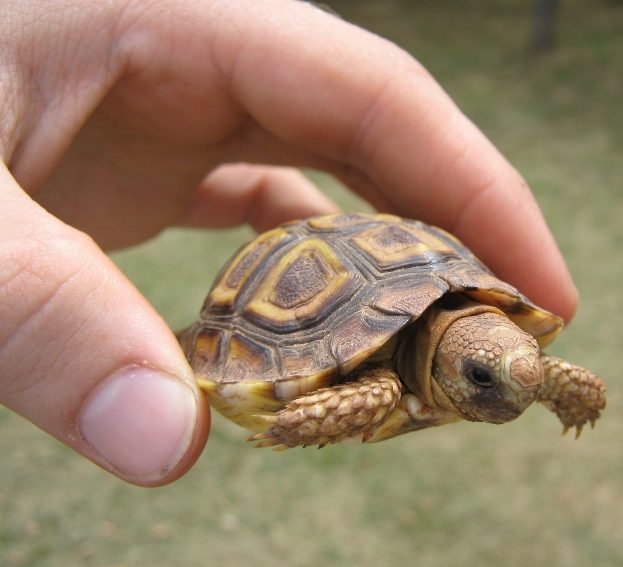
The Cape Speckled flat or Namaqualand turtle (Homopus signatus) is a land species. She is the smallest in the world. The length of the carapace, painted in light beige with black patches, is only 9 cm in females and 11 cm in males. The weight of the newborn reptile is only 5-8 grams, and in adults it ranges from 95 to 165 g.
On a note. During drought, the body weight of these animals is significantly reduced, but they do not lose the ability to reproduce offspring even in such conditions.
The modest size allows reptiles to deftly hide in crevices of rocks and become almost invisible against their background. You can meet them in South Africa, namely in semi-arid areas - the Northern and Western Cape. It extends from the Orange River in the north to Pickberg in the south, from the Atlantic coast in the west to Calvinia in the east.
By 1996, the species Homopus signatus was on the verge of extinction and was listed as vulnerable in the South African Red Book.
How much do sea turtles weigh?
Sea turtles belong to the superfamily Chelonioidea, including 2 subfamilies. All species combine such distinctive features as a heart-shaped or oval shell, consisting of horny shields, non-retractable limbs in the form of fins and a large head that the animal cannot completely hide under the shell. On average, they are larger than their land and freshwater counterparts.
Did you know? The structure of marine reptiles has remained virtually unchanged for over 80 million years, since the Mesozoic era.
Green turtle

The green or soup turtle (Chelónia mýdas) is the only one of the genus Chelonia. Despite the name, its color can be not only olive, but also brown, with white and yellow blotches.
The length of the shell of the representatives of this species is 80-150 cm, weight –70-200 kg. Very rarely found individuals up to 2 m in size and weighing 400-500 kg.
Chelonia mydas lives in the tropical and subtropical waters of the Pacific and Atlantic Ocean, feeds on jellyfish and other small marine inhabitants.
Olive turtle
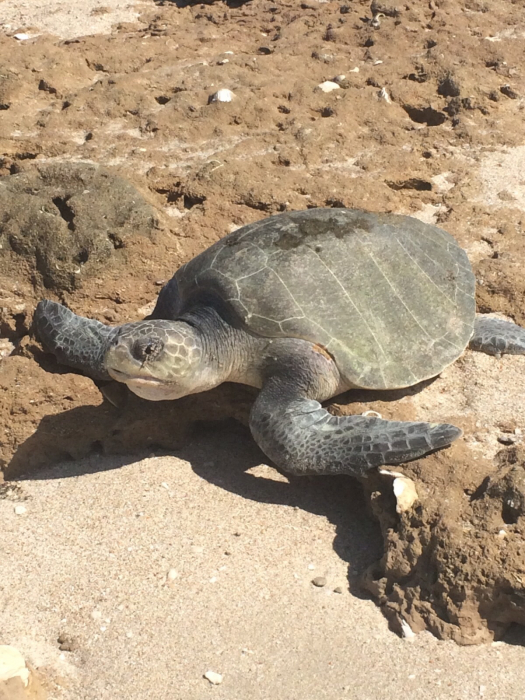
The olive turtle or olive ridley (Lepidochelys olivacea) has a shell that is thickened at the top and curved in front, which looks like a bridge. The head is wide, triangular in shape. The length of the carapace in an adult reaches 60-70 cm, weight - 45 kg.
These reptiles live in the tropical Pacific and Indian Ocean. There were times when they met in the Caribbean, near Puerto Rico. In many countries their capture is prohibited or limited, and beaches suitable for breeding individuals and laying eggs are protected.
Bissa

Byssa (Byss, real caretta) is a representative of the genus Eretmochelys. Its range is very extensive - from temperate northern to moderate southern latitudes. It is found in the Pacific, Atlantic and Indian oceans. For living, he selects lagoons, rocky shallow waters and coral reefs. It feeds on algae, mollusks and arthropods.
The carapace of the reptile is covered with thick horny scutes, has a heart-shaped, narrowed to the back of the form. Color - brown, with yellow spots. There are claws on the front flippers, usually 2 each.
The sizes of the beads are from 60 to 80 cm, weight - 40-60 kg. Species listed in the International Red Book as endangered.
Atlantic Ridley

Atlantic Ridles (Lepidochelys kempii) are the smallest, but at the same time the fastest growing of their marine counterparts. Listed in the IUCN Red List as endangered.
Most often, these reptiles can be found in southwest Florida and the Gulf of Mexico. But sometimes they are seen in Bermuda and Malta, in France and Spain, Belgium, the Netherlands and Ireland, off the coast of Great Britain, Not far from Morocco and Venezuela.
Ridley’s carapace is gray-green, heart-shaped, with a triangular head. Body dimensions reach 77 cm, weight - 45 kg.
It is interesting. Females of Lepidochelys kempii are larger than males, and their tail is shorter. In addition, they do not have a thick claw on their forepaws, while males have it.
Loggerhead

The species Caretta caretta has another name - the big-headed turtle. These are the only representatives of the Loggerheads clan. They live in the Pacific, Atlantic and Indian oceans. In Russia, they were found in the Barents Sea, the Kerch Strait and the Far East.
Outwardly, it is a massive reptile with a large head and a thick, heart-shaped carapace. It is painted brown, sometimes with a reddish tint, color, and may also be olive.
The body length of an adult is from 70 to 95 cm. Everything can reach 80-200 kg.
Freshwater species
The family of freshwater Emydidae is very extensive and includes 25 genera and 77 species. As a rule, these reptiles have medium or small sizes, an oval streamlined shell and developed limbs with sharp claws. Many of them have a bright, beautiful color.
Cayman Turtle
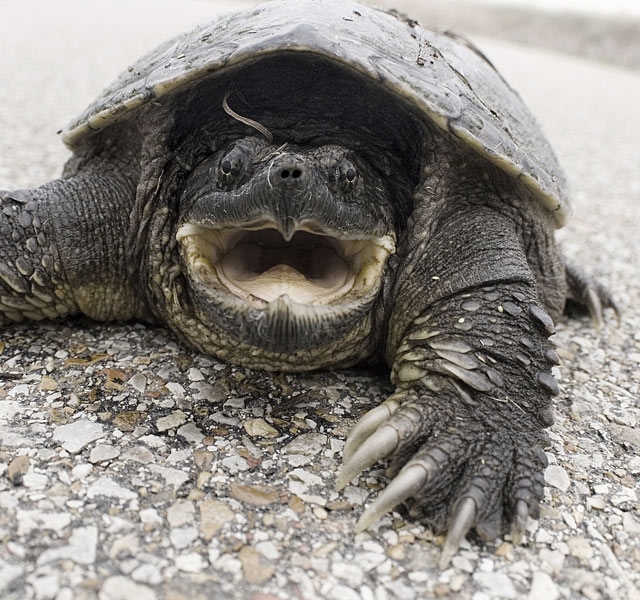
Cayman or biting turtle (Chelydra serpentina) is a member of the genus Chelydra. She got her second name for her violent temper - when trying to catch her, the person runs the risk of facing aggression - the reptile will actively defend itself and bite.
These animals can be found in the east and in the central regions of the USA, in the southeastern part of Canada. These are large individuals with a body length of up to 35 cm and a weight of up to 14 kg. Individual reptiles of this species can reach 30 kg.
They live in various reservoirs mainly with a muddy bottom. They feed on fish, small aquatic animals, waterfowl. They do not disdain carrion, but at the same time they are excellent hunters - they have powerful clawed paws and developed jaws, which allows grabbing and tenaciously holding prey.
Vulture (Macrochelys temminckii)

Vulture or alligator turtle belongs to the subfamily Chelydrinae. She is considered the largest of her freshwater counterparts. The length of her carapace is 66-80 cm, and weight is 60-91 kg. The maximum body weight of representatives of this species was reached by an individual who weighed 113 kg.
This is a reptile with a dark brown carapace decorated with 3 large longitudinal ridges. She has a large head, a muscular neck and a long tail, massive legs with membranes between the fingers.
Inhabits Macrochelys temminckii in the southeastern United States. Prefers muddy ponds with abundant vegetation. It feeds mainly on fish, but can eat worms, crustaceans, snails and snakes. It hunts waterfowl and its small relatives, sometimes eats plants.
Far Eastern tortoise (Pelodiscus sinensis)
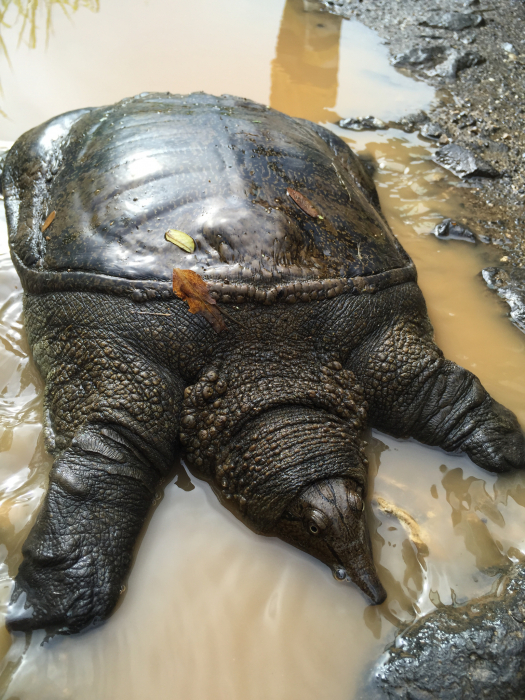
The second name of the species is Chinese trionix. This is a representative of the genus of three-clawed turtles, lives mainly in Asian countries. In some of them, these reptiles are bred on an industrial scale for further consumption. In Russia, they can be found only in the Amur and Khankai regions.
Trionix has a round shell without horny shields, covered with soft skin. It is painted in gray-green color, has yellow spots. The head, paws and neck are gray or brown, with a green tint. The body length of the reptile is 20-25, sometimes up to 40 cm. Weight - a little more than 4 kg.
Interesting fact. Recently, an individual weighing over 11 kg and a length of 46 cm was caught near Taiwan in Tainan.
Large soft-bodied Cantor (Pelochelys cantorii)
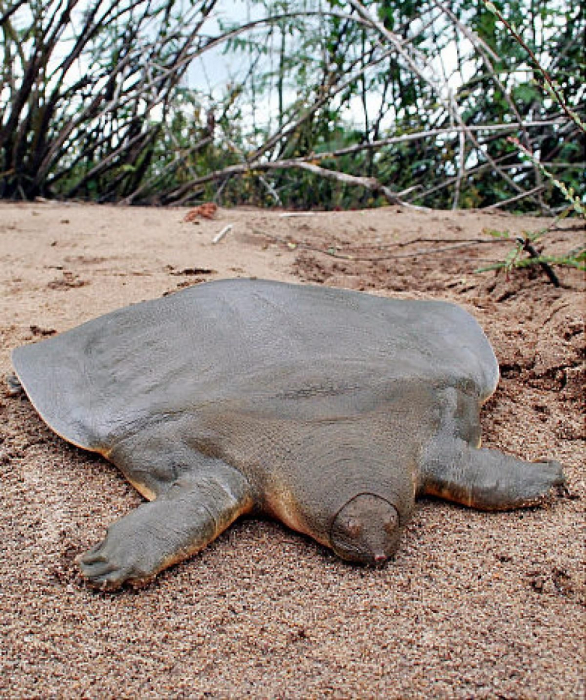
This species also belongs to the three-tailed. Reptiles have a smooth carapace with tubercles in the upper part. Moreover, in young individuals there are no protrusions, they appear only in adult animals. The length of the carapace reaches 2 m, body weight - 50 kg.These are one of the largest freshwater turtles.
Representatives of the species are found in Burma, Thailand, India, Malaysia, Indonesia, South China, Vietnam, Cambodia and the Philippines. They prefer to settle in reservoirs away from the sea, eat both plant and animal food.
Interesting fact. It is believed that such a wide distribution of the species is associated with the ability of individuals to overcome strains with sea water. Another version - they are imported by local residents for the purpose of eating meat and reptile eggs.
Pond slider
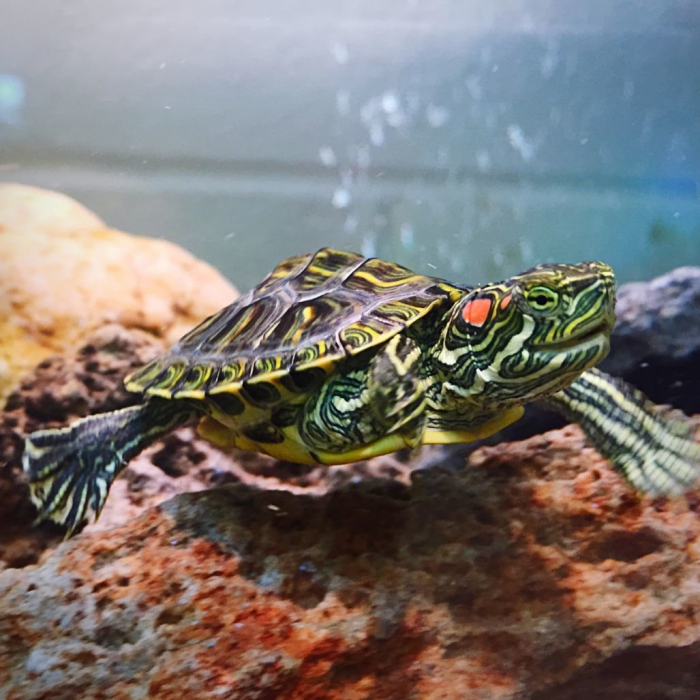
Ruby-eared or yellow-bellied tortoise is widespread. She lives in the USA, Mexico, Central and South America, South Africa, Japan, Vietnam, Thailand, Malaysia and Singapore. It settles in shallow reservoirs with low silty shores. In Russia, it is impossible to meet in natural conditions, but it is very popular among aquarists.
The reptile shell is olive, with a yellow pattern. The abdomen is yellowish in color, and on the head, near the eyes, there are elongated spots of red color - for this the reptile got its name.
An individual grows up to 7-10 years. At the age of one year, the sizes of the carapace are varied from 2.5 to 3 cm, and the weight is from 1.2 to 4 g. But when the growth stops, these figures are 17-20 cm and 0.7-1.2 kg, respectively.
Interesting fact. In Australia, where red-eared turtles appeared relatively recently, they are officially recognized as pests crowding out the local repto fauna.
Land species
Land turtles belong to the family Testudinidae, which includes 16 genera and 57 species. Among them, there are both small, slightly more than 10 cm in length, and giant animals. But large species live only in the Galapagos and Seychelles.
Elephant turtle
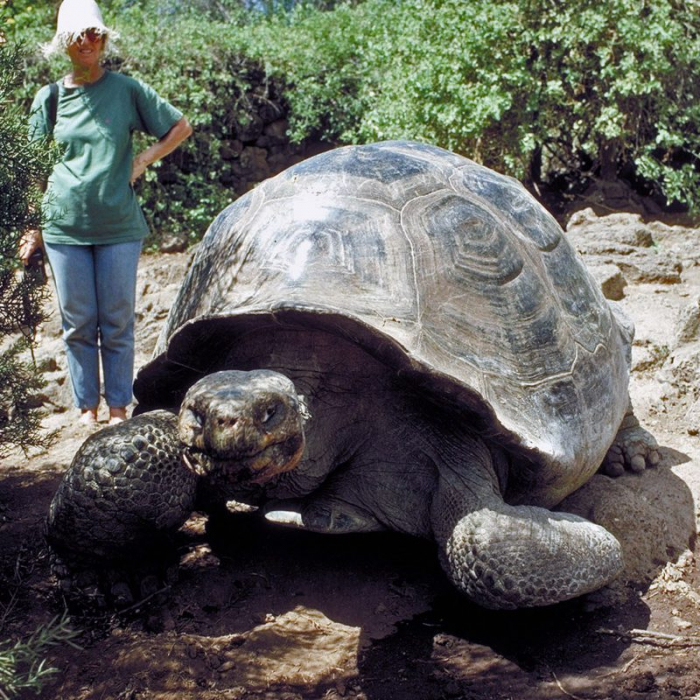
The species Chelonoidis elephantopus is also called the Galapagos tortoise, according to the distribution area. She feeds on plants, including those that are toxic to other animals.
These are huge reptiles, the shell size of which reaches 122 cm, and body weight - up to 300 kg. According to some reports, individuals up to 180 cm long and weighing more than 400 kg were found.
The shape of the carapace is different in different populations. In reptiles that live on islands with humid highlands, it has the shape of a dome, and in those that live in dry lowlands, the shell is flatter. Its color is light brown, with a characteristic pattern of plates.
Interesting fact. Elephant turtles are considered centenarians. In the wild, they survive to 100 years, and in captivity to 170.
Giant, Seychelles (Aldabrachelys gigantea)

A giant reptile lives on the Seychelles and Mascaren Islands, choosing plains, shrubs or marshes. It was previously distributed in Madagascar.
She has a bone shell, rather dense, has a neck shield. It is on this basis that reptiles can be easily distinguished from an elephant tortoise. The length of the carapace in adults varies from 105 to 120 cm, and body weight reaches 120 kg.
Giants feed mainly on plant foods - roots, vegetables, fruits, grass and dry foliage.
Leopard tortoise
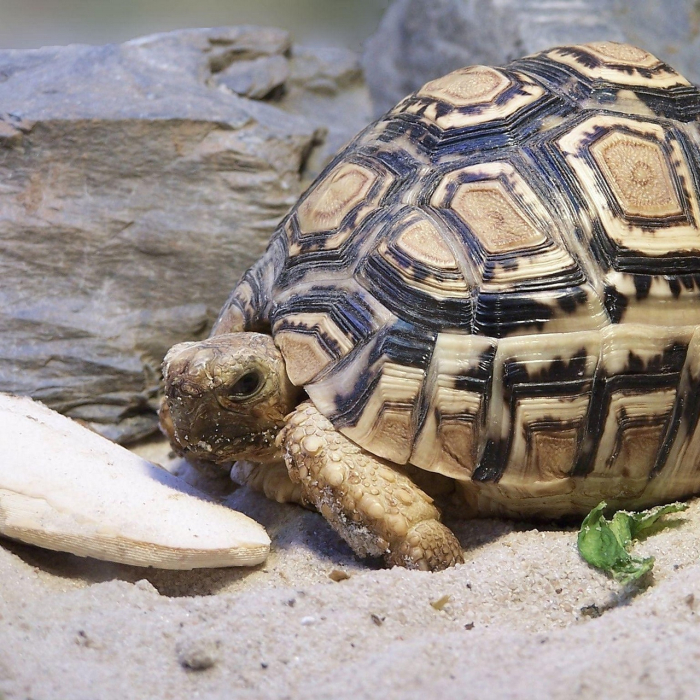
Panther or leopard tortoise (Stigmochelys pardalis) is common throughout Africa. He chooses savannah and dry highlands for living, but can live at an altitude of up to 2 km above sea level. She is the second largest among her relatives living on this continent. The length of the shell is up to 70 cm, body weight - up to 50 kg.
This is a beautiful reptile with a leopard-colored carapace - sand-yellow, decorated with a black-brown pattern. With age, it becomes not so bright.
Individuals feed on plant foods, fruits and herbs, but if they are deficient, they can go to the animal.
Radiant Tortoise (Astrochelys radiata)

This is a very rare species found only in the south and southwest of Madagascar. For living, she chooses xerophytic forests with cactus-like shrubs and herbs. It feeds mainly on vegetation, but when the opportunity presents itself, it also eats animal food.
The reptile attracts attention with the beauty of the shell. It is tall, black-brown, with a yellow pattern in the form of converging rays. In adults, the length of the carapace is from 24 to 39 cm, and body weight reaches 13 kg.
Stretch tortoise (Malacochersus tornieri)
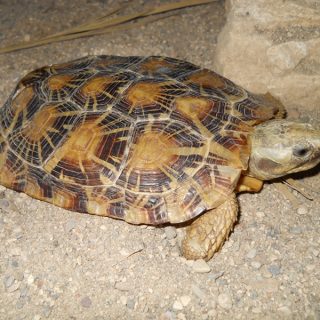
In another way, this turtle is called flat-shell. Her carapace is really flat, and also soft, consisting of thin plates. It is able to contract so that from the abdominal side you can notice how the body of the animal contracts during respiratory movements.
The shell color is golden, with brown stripes, length - from 15 to 18 cm. Females weigh a little more, up to 550 g, and males - about 360 g.
Elastic turtles are found in southern Kenya and northeast Tanzania. They live in the mountains and foothills, climb beautifully on sheer cliffs. They can clog even into narrow cracks, thereby justifying their name.
They feed mainly on vegetation; they can eat dry grass. Water is consumed in small quantities.
Mexican gopher (Gopherus flavomarginatus)
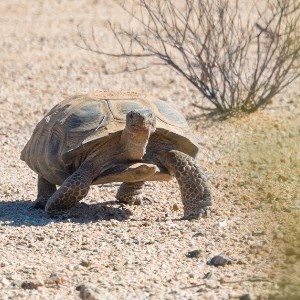
This species lives in Mexico. It inhabits grassy hills, lives in the mountains, rising to 1-1.4 km above sea level. The species is endangered and is listed in the Red Book. Many populations no longer exist, while others are on the verge of extinction.
The Mexican gopher has a tall, slightly flattened carapace, shaped like a dome. It is painted brownish yellow. With front legs with powerful claws, the animal can dig the ground if necessary. The size of the carapace of an adult reptile reaches 40 cm, weight - 14 kg. The gopher eats plants, and the basis of the diet is the cereal grass Hilaria mutica.
In this article, not all types of turtles are listed - there are hundreds of them. Unfortunately, many of them are endangered, and you can see these unique animals only in several corners of the planet.












